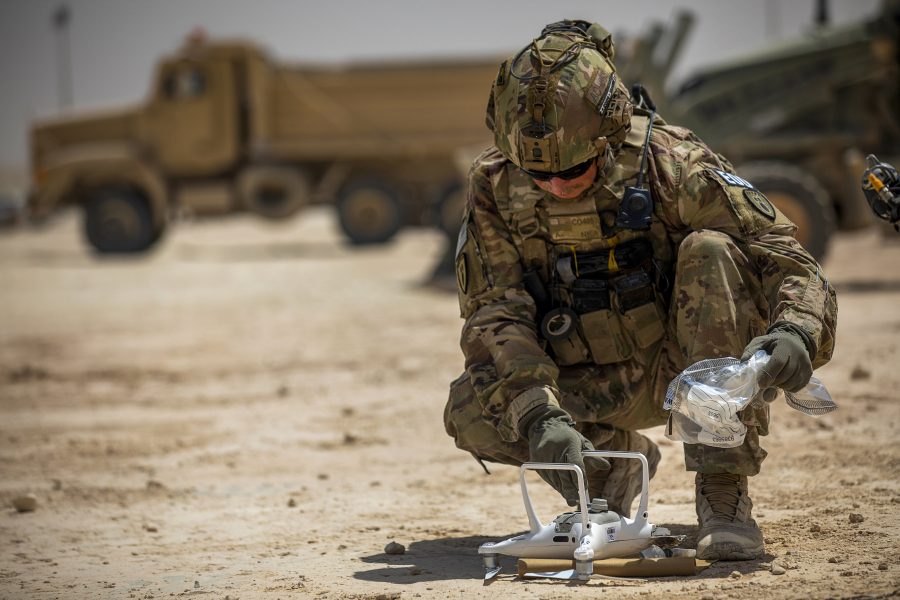Two drone attacks were launched against U.S. forces in Iraq in the span of 24 hours, the U.S. military said Oct. 18.
The attacks, which took place in western and northern Iraq, came as a wave of unrest swept Arab nations over Israel’s clash with Hamas. They are also the first attacks on U.S. forces in Iraq by suspected Iranian-backed militias in more than a year.
U.S. officials said the targets of the drone attacks were al Asad air base in western Iraq and al Harir air base in the Kurdistan region of northern Iraq. U.S. efforts to defend against the drones were largely successful, though some coalition forces suffered minor injuries, U.S. Central Command (CENTCOM) said in a statement. A U.S. defense official said drones were engaged by ground-based systems.
“In the last 24 hours, the U.S. military defended against three drones near U.S. and Coalition forces in Iraq,” CENTCOM said in a statement released on Oct. 18. “In western Iraq, U.S. forces engaged two drones, destroying one and damaging the second, resulting in minor injuries to coalition forces. Separately in northern Iraq, U.S. forces engaged and destroyed a drone, resulting in no injuries or damage.”
The U.S. military has been on high alert following Hamas’ surprise attack on Israel on Oct. 7 and the punishing air strikes Israel mounted in response.
Hezbollah, the Lebanese militia group, has also launched rocket strikes against Israel but has held back for now from launching a full-fledged missile attack.
Both Hamas and Hezbollah are backed by Iran. Experts said the attacks in Iraq also appeared to be conducted by Iranian-backed militant groups.
“To put it simply, the Iraqi militias, backed by Iran, have been wanting to find a way to get involved since this started,” said Michael Knights of The Washington Institute for Near East Policy.
U.S. officials have been worried that Iran might seek to escalate the conflict between Hamas and Israel. President Joe Biden has ordered two aircraft carrier strike groups to the Eastern Mediterranean and sent more aircraft to the region to try to deter Hezbollah and Iran.
On Oct. 16, Biden spoke to Iraqi Prime Minister Mohammed Shia Al-Sudani and discussed “ongoing efforts to prevent an expansion of the conflict in Gaza in the wake of Hamas’s abhorrent attack in Israel,” according to a readout of the call from the White House.
“This is very much all evidence of a kind of region-wide network of Iranian proxies all seeking to kind of back each other up, reinforce each other’s operations,” said Charles Lister, director of the Syria and Countering Terrorism and Extremism program at the Middle East Institute. “What everybody’s been concerned about for the last several days is that the U.S. forces in Iraq and Syria would become sort of sitting targets for Iranian retaliation for everything happening in Gaza.”
The U.S. has about 2,500 troops in Iraq who are advising Iraqi forces that are fighting Islamic State group militants and some 900 troops in Syria who are working with local partners to combat ISIS.
Since Hamas’ attack on Israel, the U.S. has stepped up its intelligence, surveillance, and reconnaissance efforts with both manned and unmanned platforms to look for signs of escalation in the region, according to a U.S. official.
“In this moment of heightened alert, we are vigilantly monitoring the situation in Iraq and the region,” CENTCOM said in its statement.
The firepower the U.S. has sent to the region includes the USS Gerald R. Ford aircraft carrier, whose four fighter squadrons and other aircraft have been operating off in the eastern Mediterranean Sea. The Ford is accompanied by cruise missile-carrying warships.
U.S. Air Force F-15E Strike Eagles, A-10 Thunderbolt II attack aircraft, and F-16 Fighting Falcons multirole fighters have also been sent to the Middle East, in addition to the fighters that were previously in the region. Another American carrier, the USS Dwight D. Eisenhower, is on its way to the Eastern Mediterranean, also accompanied by other warships.
On Oct. 17, the Pentagon said 2,000 troops were being placed in a heightened state of readiness in case they needed to deploy to the region.
The USS Bataan, which carries about 2,400 Marines, as well as fighters and helicopters, was headed closer to Israel in case it is required, Deputy Pentagon Press Secretary Sabrina Singh said Oct. 17. The Bataan is currently operating near the Red Sea, according to U.S. officials.
“We want to emphasize U.S. forces will defend U.S. and Coalition forces against any threat,” CENTCOM said.
